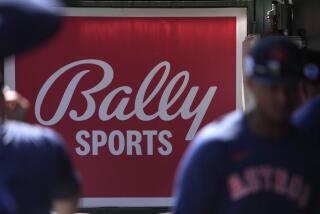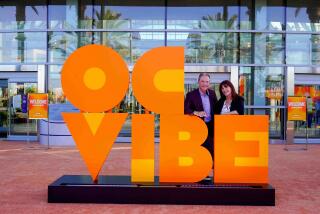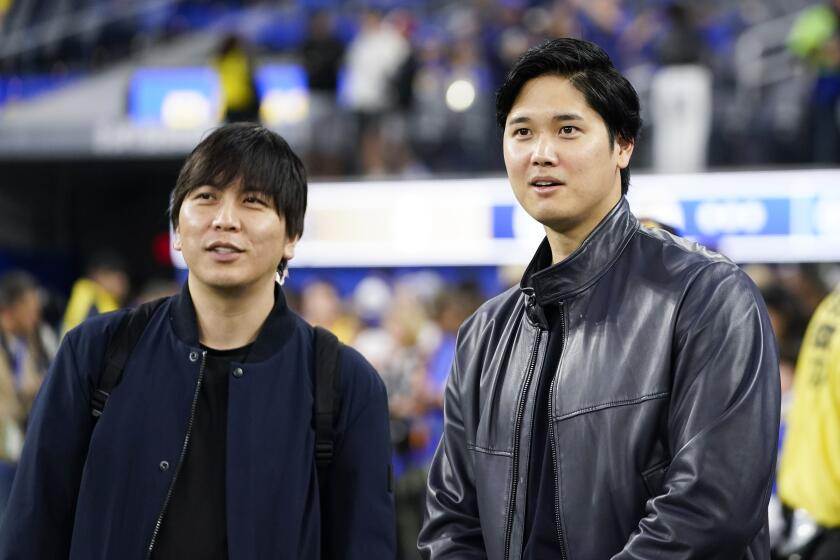Angel Fans In for a Season of Rebuilding
ANAHEIM — Soon after the Angels conclude their final homestand of the 1996 season next week, the demolition crews will move in. Where outfield seats now stand largely empty, a testament to yet another disappointing baseball season, workers in hard hats will begin Anaheim Stadium’s $100-million metamorphosis.
In a little more than 18 months, the Angels expect to have a 45,000-seat, baseball-only stadium--plans for which have been altered significantly since they were unveiled in May.
But between the first swing of the wrecking ball in early October and the first swing of the bat in 1998, the Angels will play a season in a stadium that fans may find less appealing to behold and more difficult to endure.
“I don’t think people are going to be overly disgusted with what they see, if we are creative about the way we do this,” Disney Sports Enterprises President Tony Tavares said.
“People will live with it for a year. Everyone understands there is a light at the end of the tunnel.”
Bernie Ginsbarg isn’t so sure. He has been attending Angel games since 1961, when the Angels began playing in Los Angeles’ Wrigley Field. He followed the team to Dodger Stadium and then to Anaheim. He worked on the committee to bring the team to Orange County and has held season tickets in the same location for the past 31 seasons.
Ginsbarg, 72, now wonders where he will be sitting next season.
“They are talking about building dugout suites and that’s where my seats are located,” Ginsbarg said. “That worries me. I don’t know what to expect next season.”
The stadium, which must be ready for use for the Angels-Dodgers exhibition series in late March, will look the same from the outside, except for a few missing concrete panels.
But the changes inside will be drastic. Seating capacity will be temporarily reduced from 64,593 to less than 30,000. Some seats behind home plate and the entire club level will be closed, forcing the relocation of a few thousand season-ticket holders, Disney officials said. But no decision has been made yet on where they will be moved, they said.
Some seats in the right- and left-field corners also will be closed.
Disney officials said concessions and restrooms will be closed only in areas where seats are removed. There also said there will be adequate parking for fans.
The remodeling job has changed considerably since Disney and the city of Anaheim reached an agreement in May on the renovation. The stadium opened in 1966, then was expanded and enclosed in 1980 to accommodate the Rams after the National Football League team moved from Los Angeles. Disney insisted on changing it back to a baseball-only facility, a project that was supposed to take three years. Disney officials decided to speed up the process, even if it meant working during the 1997 season.
“It’s probably going to be uncomfortable at times, but I think it’s going to be worth it,” said Anaheim resident Dave Coombs, a season-ticket holder for 16 years. “I doubt there is any way to do it without causing some kind of problem. We’ll just have to take our medicine. It’s depressing to look out at those empty outfield seats.
“Actually, they can enclose the stadium or dome it, I don’t care. But what I would like to see them do is build a winning team.”
First things first, according to Disney officials.
“I think fans are going to get a kick out of it,” said Kevin Uhlich, stadium director for the Angels. “They will come back and see the outfield area open and can follow the progress through the season. There is going to be a reason to come out and see what is going on.”
Said Ginsbarg, on the other hand, “I think it’s a lot of money and I think it’s going to be an inconvenience for fans.”
Ginsbarg, like other Angel fans, is not sure what Disney plans to do with the stadium next season. Disney officials said season-ticket holders will receive construction updates in the mail from the day the renovation begins through opening day, 1998.
“I hear a lot of rumors,” said Ginsbarg, who has lived in Anaheim for 42 years. “The mayor is my next door neighbor and I keep asking him what’s going to happen. Either he’s not telling me or even he doesn’t know.”
The remodeling plan is still “evolving” and won’t be finalized until later this fall, according to Disney officials. But the stadium design has already changed because of budget and structural concerns.
“I’m sure there’s going to be [logistics] problems,” said Anaheim resident Bob Boswell, a season-ticket holder for eight years. “It makes you think. If you usually buy four season tickets, do you now buy only two? Personally, I don’t think they are going to get as far along with the construction as they think.”
Plans to move the Big A scoreboard, long the stadium’s symbol, inside the stadium will likely be dropped. The structure was moved from behind the left field fence to the parking lot in 1980. Its return inside was heavily promoted by Disney officials before the deal was approved by the Anaheim City Council. Disney officials now say it may be too fragile to move again. Building a smaller version inside is being considered.
The other changes were made because of budget constraints. Disney will pay $70 million of the estimated $100-million renovation costs and officials say they have concluded that $100 million doesn’t go quite as far as they once thought it would in renovating the stadium.
A restaurant in left field and a water fountain “extravaganza”--which would erupt after Angel home runs--have been dropped. Both were part of the initial plan.
“We’ve added things that were never in the original conception and we had to take some things out that we didn’t think were quite as important,” Uhlich said. “We need to keep this project at $100 million. It’s a juggling game to make sure the final project is at that point.”
Tavares said Disney has studied and borrowed ideas from other stadiums. Busch Stadium, the St. Louis Cardinals’ home, underwent a $7-million renovation during the off-season, which included creating a popular picnic area behind the left-center field fence. Anaheim Stadium will have a picnic area in the same place.
Coors Field in Denver has a picnic area as well, plus a walkway around the stadium and seats behind both outfield fences. Anaheim Stadium will have a walkway that circles the stadium on the terrace level, and 1,500 seats beyond left field have been added. That has allowed officials to drop plans for a view level, or third deck, in right field.
The right-field fence will be raised to allow for an out-of-town scoreboard, like the one in Baltimore’s acclaimed Camden Yards.
“Every time we see something that we think will work better than what we had planned, we kind of embrace it and see whether or not we can afford it in our budget,” Tavares said.
The Angels will not be the first baseball team to play while their stadium is renovated. In fact, this won’t be the first time for the Angels.
The team played in Anaheim Stadium in 1980 while a $33-million face lift added about 27,000 seats. The team drew nearly 2.3 million fans despite the ongoing construction. But that was the season that followed the Angels’ first division championship.
The Oakland A’s were not so fortunate this year. A’s officials said the Oakland Coliseum expansion, which was part of the deal that lured the football Raiders, was a distraction to fans. The A’s are averaging 13,888 fans this season, the lowest in the major leagues.
While they are seven games under .500, the A’s have an exciting team, one that is second in the major leagues in home runs. The Detroit Tigers, who have lost 100 games, have averaged 14,869.
Construction continued even during A’s games. Fans were often forced to watch baseball to the sound of buzz saws, jackhammers and other heavy machinery. The constant work was necessary because the work had to be finished by Aug. 8.
“We lost a good part of our food services and some restroom areas,” A’s Executive Vice President Ed Alvarez said. “We did not realize until the project was well under way that we wouldn’t have a public concourse in front of the stadium. As a result, we had to deal with unique directional signs.”
Alvarez said the problems stemmed from the tight deadline and the fact that the A’s were not involved in the planning. Disney officials face neither of these handicaps.
The A’s were also forced to open the season at a minor league park, playing six games in Las Vegas, because of construction delays and safety concerns.
The Angels do not have a contingency plan at this time to shift games to another ballpark if Anaheim Stadium is not ready.
The only work that could prevent the Angels from playing in the stadium will be done behind home plate, where the clubhouses and press box will be redone and construction will be started on the new dugout-level suites.
“I pretty much know what was going on in Oakland,” Tavares said. “We don’t foresee any delays at this point.
“We will not we be working while the team is playing. We might be when the team is practicing, but certainly not when the game is going on.”
Tavares said the big projects are scheduled to be completed well before the season begins. A football press box, now used only as a stadium club, will be torn out and replaced by seats.
Gone, too, will be the left-field area that was damaged by the 1994 Northridge earthquake. The city spent $10 million--$5 million from the Federal Emergency Management Authority--to make repairs. The $3.6-million scoreboard, which replaced the one that fell during the earthquake, will be moved to the left-center field area.
But construction on the terrace level behind home plate, the right and left field corners and the club level will leave large areas unusable. Uhlich said the club will lose 4,000 to 5,000 seats on the club level, many of which belong to season-ticket holders.
“We’re still going to have the vast majority of our good seats,” Tavares said. “We’re taking out many of the seats that have been difficult to sell in the past.”
And fewer seats can be an advantage, according to Disney officials.
“Angel tickets might become a commodity,” said Bill Robertson, public relations director for Disney Sports Enterprises. “Tearing down the seats would give people a heightened awareness about tickets. But that’s not why we’re doing it.”
The reason, Robertson said, will be made clear to those attending games. There will be a scale model of the finished product outside the stadium throughout the 1997 season. Angel officials who speak to local groups already bring with them the latest artist’s conceptions.
To Ginsbarg, the issue is yet to be decided. “I don’t know if the construction is going to bother me or not. But the team’s play might affect me.”
(BEGIN TEXT OF INFOBOX / INFOGRAPHIC)
Big A Make-Over
Baseball fans will find Anaheim Stadium is a work in progress next season, as Disney transforms the ballpark from the inside out. Expected changes include:
1. Entire outfield seating section, plus an unspecified number of seats in right- and left-field corners, will be torn out. (Some of the seats will be replaced for the 1998-99 season)
2. Scoreboard will be moved to center field; original Big A scoreboard likely will remain in parking lot.
3. Terrace level seats directly behind home plate will be removed for construction of press box and suites.
4. Most of club level will be closed throughout the season.
5. Football press box will be removed and replaced by seats in time for the 1997 baseball season.
* Anticipated completion: April 1, 1998
* Anticipated cost: $100 million
More to Read
Go beyond the scoreboard
Get the latest on L.A.'s teams in the daily Sports Report newsletter.
You may occasionally receive promotional content from the Los Angeles Times.







